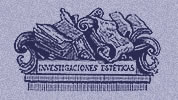 |
A pesar de que actualmente se encuentra
en la reserva de Tohono O’odom en el suroeste moderno de
Estados Unidos, cuando la iglesia franciscana de San Xavier del
Bac (1780-1797) fue construida, su ubicación
era la frontera norte de la Nueva España. Desde el
principio la iglesia sobresalió de las otras misiones del
norte de la Nueva España por su elaborada decoración,
y todavía se distingue porque su contenido ha permanecido
intacto. Este ensayo es una introducción a la iglesia como
sujeto de estudio de la historia del arte. Se resaltan los siguientes
temas: la relación entre el programa franciscano con el
jesuita que le precedió en una iglesia anterior en el emplazamiento,
la disposición franciscana original de las figuras, los
vínculos de estilo entre las esculturas y lo que significaban
sobre el (los) taller (es) de la Nueva España de donde debieron
haber sido importados; los pintores y enlucidores que trabajaron
en la iglesia misma, y la posibilidad de distintas lecturas del
programa creado por los españoles, sucesivos religiosos
que lo alteraron, y generaciones de congregaciones autóctonas.
Para documentar las ideas franciscanas del siglo XVIII, la iglesia
de Bac proporciona evidencia, que aparentemente no está disponible
en ningún otro lado, sobre la transferencia de propiedades
e ideas jesuitas después de la expulsión de
la orden de territorios españoles en 1767.
|
 |
 |
 |
Although now on the Tohono O'odom reservation
in the modern US Southwest, when the Franciscan church of San Xavier
del Bac was built (1780-97), its location was the northern frontier
of New Spain. From the outset the church stood out from other
northern New Spanish missions in its elaborate decoration, and
it still stands out because its contents remain intact, despite
changes through time. This essay serves as an introduction
to the church as a subject of art historical study. It highlights
the following topics: the relationship of the Franciscan
program to the Jesuit program that preceded it in an earlier church
at the site, the original Franciscan arrangement of figures, style
linkages among the sculptures and what they imply about the New
Spanish workshop/s from which they must have been imported, the
painters and plasterers who worked at the church itself, and the
possibility of different readings of the program by the Spaniards
who created it, succeeding religious who altered it, and generations
of native congregations. In addition to documenting eighteenth-century
Franciscan ideas, the church at Bac provides evidence seemingly
not available elsewhere about the transferral of Jesuit properties
and ideas after the order’s expulsion from Spanish territories
in 1767.
|






